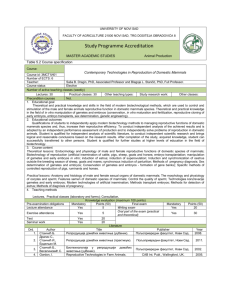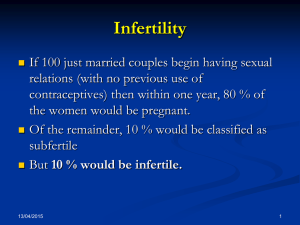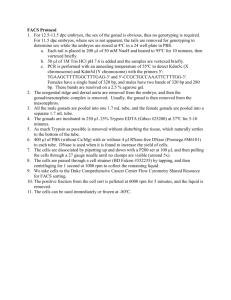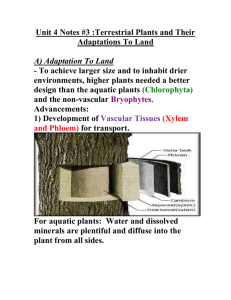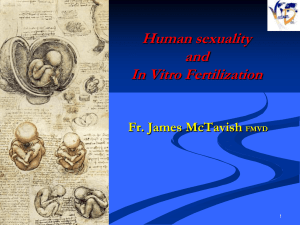Human reproductive research - Acart
advertisement
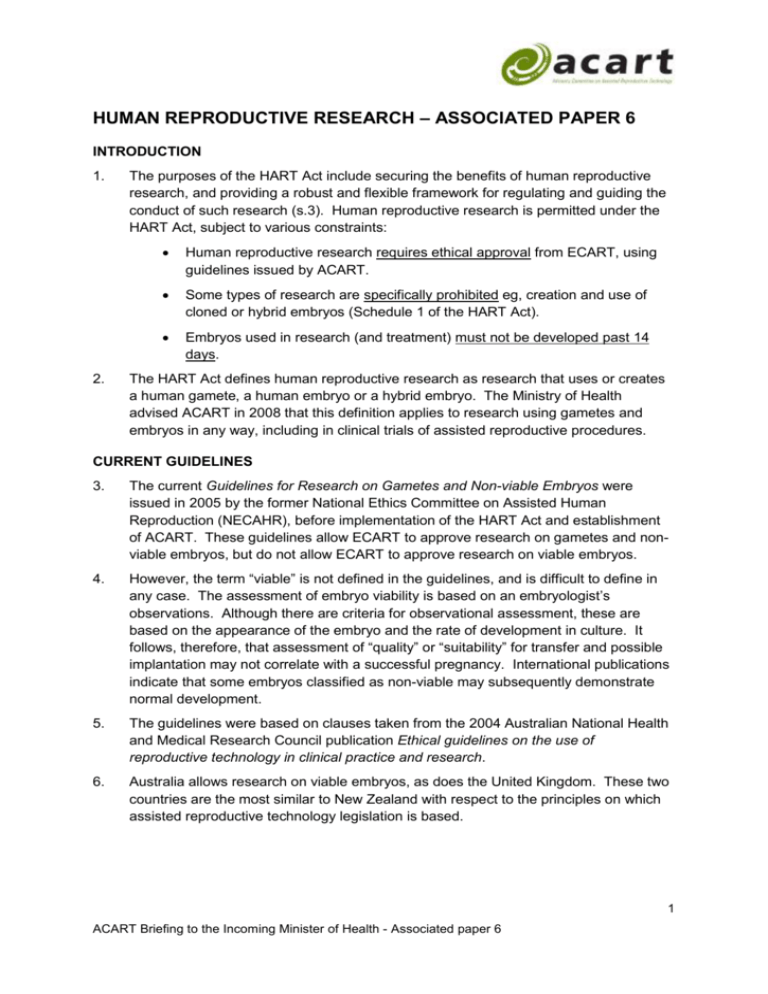
HUMAN REPRODUCTIVE RESEARCH – ASSOCIATED PAPER 6 INTRODUCTION 1. 2. The purposes of the HART Act include securing the benefits of human reproductive research, and providing a robust and flexible framework for regulating and guiding the conduct of such research (s.3). Human reproductive research is permitted under the HART Act, subject to various constraints: Human reproductive research requires ethical approval from ECART, using guidelines issued by ACART. Some types of research are specifically prohibited eg, creation and use of cloned or hybrid embryos (Schedule 1 of the HART Act). Embryos used in research (and treatment) must not be developed past 14 days. The HART Act defines human reproductive research as research that uses or creates a human gamete, a human embryo or a hybrid embryo. The Ministry of Health advised ACART in 2008 that this definition applies to research using gametes and embryos in any way, including in clinical trials of assisted reproductive procedures. CURRENT GUIDELINES 3. The current Guidelines for Research on Gametes and Non-viable Embryos were issued in 2005 by the former National Ethics Committee on Assisted Human Reproduction (NECAHR), before implementation of the HART Act and establishment of ACART. These guidelines allow ECART to approve research on gametes and nonviable embryos, but do not allow ECART to approve research on viable embryos. 4. However, the term “viable” is not defined in the guidelines, and is difficult to define in any case. The assessment of embryo viability is based on an embryologist’s observations. Although there are criteria for observational assessment, these are based on the appearance of the embryo and the rate of development in culture. It follows, therefore, that assessment of “quality” or “suitability” for transfer and possible implantation may not correlate with a successful pregnancy. International publications indicate that some embryos classified as non-viable may subsequently demonstrate normal development. 5. The guidelines were based on clauses taken from the 2004 Australian National Health and Medical Research Council publication Ethical guidelines on the use of reproductive technology in clinical practice and research. 6. Australia allows research on viable embryos, as does the United Kingdom. These two countries are the most similar to New Zealand with respect to the principles on which assisted reproductive technology legislation is based. 1 ACART Briefing to the Incoming Minister of Health - Associated paper 6 ACART WORK TO DATE 7. ACART issued a discussion document in 2006 on proposed advice to the Minister of Health on aspects of human reproductive research. ACART received around 350 submissions and held eight public meetings. 8. ACART’s finalised advice to the Minister of Health in 2007 included recommending the development of new guidelines on research to allow research on “surplus” viable embryos ie, embryos left over from consumers’ in vitro fertilisation (IVF) treatments, with informed consent by the consumers concerned. ACART did not recommend allowing the creation of viable embryos specifically for research. 9. The HART Act requires ACART to agree its work programme with the Minister of Health. To date, the development of new human reproductive research guidelines has not been included in the work programme. LIMITATIONS OF THE CURRENT GUIDELINES 10. 11. There are problems with the guidelines that can create confusion during application. The guidelines, and the HART Act, fail to define non-viable embryos or to define embryo viability. The wording can be construed as covering viable embryos. For example, clause 15.4.2 in the guidelines states “any risks (particularly any long-term risks to persons born) should be minimal”. If embryos are non-viable, they cannot give rise to an individual. In addition, not allowing the use of viable embryos has impacts that appear to be unintended, but have the effect of preventing the building up of knowledge through clinical trials. ECART declined a recent research application where researchers proposed to investigate if embryos transferred after day three or five (both currently used in IVF cycles) yielded a higher chance of pregnancy success. This study would use women’s own embryos and would not alter the embryos. The Ministry of Health has been recently contacted by researchers who wanted to compare different media for culturing embryos, by culturing embryos for three to five days before transferring the embryos to patients. [Note: The above paragraph has been edited to maintain legal privilege.] 2 ACART Briefing to the Incoming Minister of Health - Associated paper 6 SCOPE OF HUMAN REPRODUCTIVE RESEARCH 12. If new guidelines enabled the use of viable embryos in research, the scope of embryo research in New Zealand is likely to focus on three broad areas: improvements in embryo culture techniques. This leads to increased implantation rates through: improved methods of assessing viability of embryos; validation of new formulations of in vitro culture media; and investigation of the embryo’s use of nutrients in the culture media. Viable embryos are necessary for this research. improvements in cryopreservation techniques with a focus on improving survival rates of stored embryos and gametes, once thawed. Only viable embryos can be used to validate new techniques. development of embryonic stem cells. Embryonic stem cells are a potential therapy for numerous diseases in the future. To develop embryonic stem cells, it would be necessary to obtain viable embryos to undertake the research. 13. There are currently no feasible alternatives to embryonic stem cells. Induced pluripotent stem cells (IPS) are a type of stem cell that can be generated directly from adult cells, negating the need for embryos. However, the research is not yet at a stage where IPS cells are considered a suitable and safe alternative. 14. The definition of embryo in the HART Act does not include stem cells derived from an embryo (s.5). However, to develop embryonic stem cells, as noted above, it would be necessary to use viable embryos, which is precluded by the current guidelines. Once the stem cells are developed, their use would be regulated under the Human Tissue Act and not the HART Act. BENEFITS OF HUMAN REPRODUCTIVE RESEARCH 15. 16. Overseas research on (mostly viable) embryos has led to enhanced pregnancy success by: the refinement of embryo culture media and an improved understanding of embryo development significant improvements in cryopreservation to increase viability post-thawing improved understanding of developmental mechanisms causing chromosome abnormalities, leading to the development and use of techniques to identify disorders at the pre-implantation stage. Additionally, stem cell research has made significant progress towards benefiting the health of humans through novel treatments of disease eg, leukaemia. 3 ACART Briefing to the Incoming Minister of Health - Associated paper 6 FUTURE DEMAND FROM RESEARCHERS AND CONSUMERS 17. There is interest among New Zealand researchers in conducting research on viable embryos. Indications are that if the guidelines allowed ECART to consider and decide research using viable embryos, at least five research groups would be interested in undertaking embryo research relating to the development of human embryonic stem cells. 18. The ability for New Zealand-based researchers to conduct such research or participate in international research would be of both economic and reputational benefit. This has recently been highlighted in a publication in the New Zealand Medical Journal by Professor Gareth Jones, University of Otago.1 19. There are also indications that New Zealand consumers are interested in donating embryos for research. Embryos are able to be stored lawfully for up to 10 years. Before the lawful storage period ends, people have the option of using the embryos, applying to ECART for an extension of the storage period, donating to another person or couple, or discarding the embryos. Embryos are potentially viable in their frozen state so it is not currently possible to donate stored embryos to research. 20. From November 2014, successive groups of embryos and gametes will reach the 10 year storage limit. New guidelines that allowed research on viable embryos would give consumers a further choice about what to do with their spare embryos by allowing them to donate to research. Overseas research suggests that many people may prefer to donate embryos for research, rather than donating to other people. From a consumer perspective, donating to research can be an opportunity to contribute to future knowledge that will help other people needing assistance to have families. TIMEFRAME TO PRODUCE GUIDELINES 21. If ACART was to develop new guidelines, public consultation on proposed guidelines would be required. We anticipate that new guidelines would be produced within 12 to 18 months. 1 Jones DG. 2014. Where does New Zealand stand on permitting research on human embryos? NZMJ Vol 127 No 1399. 4 ACART Briefing to the Incoming Minister of Health - Associated paper 6

